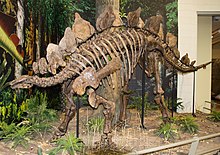Portal:Dinosaurs
IntroductionDinosaurs are a diverse group of reptiles of the clade Dinosauria. They first appeared during the Triassic period, between 243 and 233.23 million years ago (mya), although the exact origin and timing of the evolution of dinosaurs is a subject of active research. They became the dominant terrestrial vertebrates after the Triassic–Jurassic extinction event 201.3 mya and their dominance continued throughout the Jurassic and Cretaceous periods. The fossil record shows that birds are feathered dinosaurs, having evolved from earlier theropods during the Late Jurassic epoch, and are the only dinosaur lineage known to have survived the Cretaceous–Paleogene extinction event approximately 66 mya. Dinosaurs can therefore be divided into avian dinosaurs—birds—and the extinct non-avian dinosaurs, which are all dinosaurs other than birds. Dinosaurs are varied from taxonomic, morphological and ecological standpoints. Birds, at over 11,000 living species, are among the most diverse groups of vertebrates. Using fossil evidence, paleontologists have identified over 900 distinct genera and more than 1,000 different species of non-avian dinosaurs. Dinosaurs are represented on every continent by both extant species (birds) and fossil remains. Through the first half of the 20th century, before birds were recognized as dinosaurs, most of the scientific community believed dinosaurs to have been sluggish and cold-blooded. Most research conducted since the 1970s, however, has indicated that dinosaurs were active animals with elevated metabolisms and numerous adaptations for social interaction. Some were herbivorous, others carnivorous. Evidence suggests that all dinosaurs were egg-laying, and that nest-building was a trait shared by many dinosaurs, both avian and non-avian. (Full article...) Selected articlePsittacosaurus is a genus of psittacosaurid ceratopsian dinosaur from the Early Cretaceous Period of what is now Asia, about 130 to 100 million years ago. It is notable for being the most species-rich dinosaur genus. Nine to eleven species are recognized from fossils found in different regions of modern-day China, Mongolia and Russia, with a possible additional species from Thailand. All species of Psittacosaurus were gazelle-sized bipedal herbivores characterized by a high, powerful beak on the upper jaw. At least one species had long, quill-like structures on its tail and lower back, possibly serving a display function. Psittacosaurus is not as familiar to the general public as its distant relative Triceratops but it is one of the most completely known dinosaur genera. Fossils of over 400 individuals have been collected so far, including many complete skeletons. Most different age classes are represented, from hatchling through to adult, which has allowed several detailed studies of Psittacosaurus growth rates and reproductive biology. The abundance of this dinosaur in the fossil record has led to establishing the Psittacosaurus biochron for the Early Cretaceous of east Asia. (see more...) TopicsSubcategoriesSelected image
Photo credit: User:FunkMonk Did you know...
Things you can do
Featured article candidates
Peer reviews
Articles to be merged
Articles to be split
Related content
Associated WikimediaThe following Wikimedia Foundation sister projects provide more on this subject:
Discover Wikipedia using portals |





























